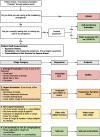Rapid design and implementation of an integrated patient self-triage and self-scheduling tool for COVID-19
- PMID: 32267928
- PMCID: PMC7184478
- DOI: 10.1093/jamia/ocaa051
Rapid design and implementation of an integrated patient self-triage and self-scheduling tool for COVID-19
Abstract
Objective: To rapidly deploy a digital patient-facing self-triage and self-scheduling tool in a large academic health system to address the COVID-19 pandemic.
Materials and methods: We created a patient portal-based COVID-19 self-triage and self-scheduling tool and made it available to all primary care patients at the University of California, San Francisco Health, a large academic health system. Asymptomatic patients were asked about exposure history and were then provided relevant information. Symptomatic patients were triaged into 1 of 4 categories-emergent, urgent, nonurgent, or self-care-and then connected with the appropriate level of care via direct scheduling or telephone hotline.
Results: This self-triage and self-scheduling tool was designed and implemented in under 2 weeks. During the first 16 days of use, it was completed 1129 times by 950 unique patients. Of completed sessions, 315 (28%) were by asymptomatic patients, and 814 (72%) were by symptomatic patients. Symptomatic patient triage dispositions were as follows: 193 emergent (24%), 193 urgent (24%), 99 nonurgent (12%), 329 self-care (40%). Sensitivity for detecting emergency-level care was 87.5% (95% CI 61.7-98.5%).
Discussion: This self-triage and self-scheduling tool has been widely used by patients and is being rapidly expanded to other populations and health systems. The tool has recommended emergency-level care with high sensitivity, and decreased triage time for patients with less severe illness. The data suggests it also prevents unnecessary triage messages, phone calls, and in-person visits.
Conclusion: Patient self-triage tools integrated into electronic health record systems have the potential to greatly improve triage efficiency and prevent unnecessary visits during the COVID-19 pandemic.
Keywords: COVID-19; coronavirus; patient portal; self-triage; symptom checker.
© The Author(s) 2020. Published by Oxford University Press on behalf of the American Medical Informatics Association. All rights reserved. For permissions, please email: journals.permissions@oup.com.
Figures
References
-
- Johns Hopkins Coronavirus Resource Center. https://coronavirus.jhu.edu/ Accessed April 18, 2020
-
- Moon S. The CDC has changed its criteria for testing patients for coronavirus after the first case of unknown origin was confirmed. CNN. 2020. https://www.cnn.com/2020/02/27/health/us-cases-coronavirus-community-tra... Accessed April 2020




